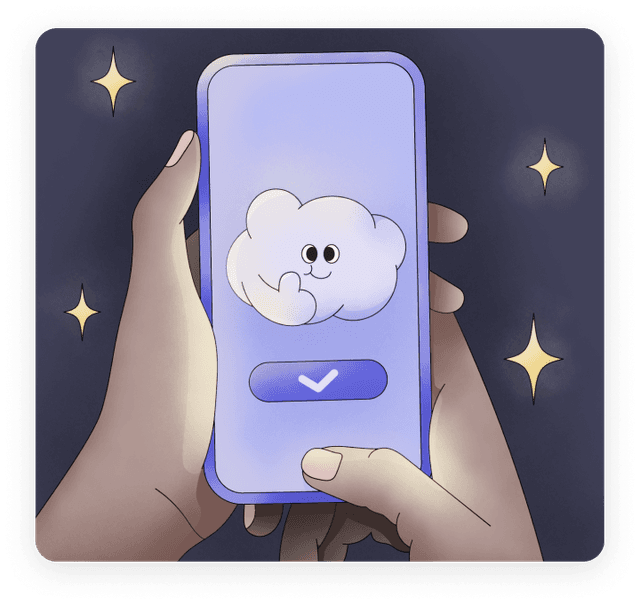
Denys Chumak
28 Aug 2023
The Science Behind Lucid Dreams
Introduction of Lucid Dreaming
Have you ever wished you could control your dreams? Just picture being able to fly through the air, run into your favourite stars, or travel to fantastical places while you're sound sleeping. Or Have you ever had the sensation of being totally conscious of your dream while it is still happening? The phenomenon known as lucid dreaming is amazing.
A survey revealed that approximately 55% of adults have encountered at least one lucid dream in their lifetime, while 23% of individuals experience lucid dreams every month.
In this blog, we will examine what is lucid dreaming, the science behind lucid dreams, and techniques for inducing them.
What is Lucid Dreaming?
A dream in which you are conscious of dreaming is called a lucid dream. You have power over the dream and can act whatever you like. It allows you to experience things that you couldn't otherwise have in real life while exploring your subconscious mind. Since ancient times, lucid dreaming has attracted people. It allows you to experience things that you couldn't otherwise have in real life while exploring your subconscious mind.
The Fascination with Lucid Dreaming
It's understandable why so many people in their early 20s, like you, are lured to its appealing opportunities. Exploring unresolved emotional issues and seeking direction for daily decisions can both be done safely in lucid dreaming.
Also Read: What Does It Mean When You Dream About The Devil?
The Science Behind Lucid Dreaming
Brain Activity during Lucid Dreams: Insights from Neuroimaging Studies
With the help of cutting-edge neuroimaging techniques, researchers have studied the brain activity that takes place during lucid dreams. This study shows that lucid dreaming increases activity in the prefrontal cortex, the part of the brain responsible for judgment and self-awareness. You can make choices and steer the plot while you're in the dream as if your conscious mind suddenly becomes cognizant.
The Link Between Lucid Dreaming and REM Sleep
The majority of our dreams take place during a sleep stage known as Rapid Eye Movement (REM) sleep, which is also closely associated with lucid dreaming. Our muscles briefly paralyse during REM sleep to prevent us from acting out our dreams physically.
But in lucid dreams, this paralysis is broken, allowing you to move around and engage with your dream world. You can enable lucid dreaming by learning to recognise the telltale indications of REM sleep and developing your awareness of those dreams.
Neurochemical Factors Influencing Lucid Dreaming Experiences
Our brains' neurochemical composition can affect whether we have lucid dreams. For instance, the neurotransmitter acetylcholine, which is important for memory and learning, greatly encourages lucid dreaming.
Your chances of experiencing lucid dreams and delving into the depths of your subconscious mind can be improved by increasing acetylcholine levels through particular procedures or even dietary changes.
Techniques for Inducing Lucid Dreams
If you're a spiritual individual in your early 20s, seeking guidance and a sense of belonging, exploring lucid dreaming might be just what you need.
Reality Testing and Reality Checks:
Daily reality checks and testing are a powerful technique to trigger lucid dreams. It's like setting up small checkpoints to see if you're dreaming or awake. Think about periodically asking yourself, "Am I dreaming?" and then looking around you.
Keep an eye out for anomalies or weird occurrences that don't match reality. Making this a habit will cause you to do it in your dreams as well, and when you notice something strange, you'll realise you're dreaming. As a result, you will become lucid and be able to direct and modify your dream environment.
Wake-Induced Lucid Dreaming (WILD):
WILD, also known as wake-induced lucid dreaming, is another method to investigate. It entails going straight from being awake into a dream state while still being conscious. Lay down comfortably and unwind your body before attempting WILD.
Try to keep your mind focused and awake when you nod off. Try to enter a dream scene in your mind or repeat a mantra like "I'm going to have a lucid dream." You can transition from wakefulness into a lucid dream state with practice.
Mnemonic-Induced Lucid Dreaming (MILD):
Setting goals before going to bed is a step in the MILD technique, which induces lucid dreams. Replay a recent dream in your head as you lie in bed, concentrating on realising you're dreaming the next time anything similar happens.
Say to yourself firmly, "I will recognise my dreams the next time I dream." Imagine waking up from that dream and carrying out the steps you'll need to. You can boost your chances of having a lucid dream by programming your mind before bed.
External Stimulation Techniques:
Techniques for external stimulation can also aid in lucid dreaming. Using tools that alter reality, such as lucid dreaming masks or specialised soundtracks, is one common technique. These gadgets provide you hints or stimulation while you're sleeping to induce lucidity. A lucid dreaming mask, for instance, may generate light signals that manifest in your dream and serve as a reminder that you are dreaming.
Similar to this, specialised soundtracks can produce noises that resemble dreams and increase your likelihood of being lucid. Exploring these techniques might be a fascinating and enjoyable method to improve your lucid dreaming.
Benefits of Lucid Dreaming
**Overcoming Nightmares:
We often feel frightened and nervous after having a nightmare. But by practising lucid dreaming, you may take back control and face your nightly fears head-on. You may turn nightmares into rewarding experiences by becoming aware that you are dreaming and understanding that you are in charge.
Consider transforming that dreadful creature into a cuddly unicorn or flying above the clouds while putting your concerns to rest. You can overcome nightmares with the help of lucid dreaming and replace them with enchanting and joyful dreamscapes!
Creative Problem Solving:
Your mind is open to fresh concepts and options when you are having lucid dreams. Without regard to constraints from the real world, you can intentionally explore many scenarios and try out new solutions.
This effective method of problem-solving can offer new viewpoints and assist you in coming up with creative solutions to problems you face in daily life. Let your dreams lead you to a solution the next time you're stuck on a problem!
Personal Growth:
A special possibility for personal development and self-discovery exists with lucid dreaming. You might discover that you're a young woman on a spiritual quest who is looking for a deeper purpose and connection.
Deep understandings of your inner self, unresolved feelings, and secret desires can be gained via lucid dreams. You can learn more about your subconscious mind, your strengths, and your objectives by deliberately examining your dreams.
Also Read: What Does it Mean When You Dream About a Goat?
Lucid Dreaming and Sleep Disorders
Sleep Apnea: A Troublesome Breathing Disorder
A person who experiences sleep apnea temporarily stops breathing while they are asleep. It happens when the airway closes off entirely or partially, causing disturbed sleep and frequent awakenings. Due to their poor quality sleep, people with sleep apnea frequently experience daytime fatigue and irritability.
You may find it difficult to have lucid dreams, in which you may direct and control your dreams, if you have sleep apnea. Because of the sleep disruptions brought on by apnea, it may be more difficult to achieve a lucid dream state. However, addressing sleep apnea might boost your lucid dreaming propensity and sleep quality.
Insomnia: The Frustration of Sleeplessness
Even when you have the chance, insomnia makes it tough to fall asleep or stay asleep. It can cause daylong sensations of fatigue, irritation, and difficulty concentrating. Stress, anxiety, and certain medical conditions can all contribute to insomnia. Lucid dreaming can give those with sleep problems a sense of escape and control, even though it won't heal their insomnia. By using lucid dreaming techniques like reality checks or dream journals, you can direct your attention away from your sleep problems and foster a more positive attitude about sleep.
Narcolepsy: Embracing the Unexpected
Because narcolepsy affects the brain's capacity to regulate sleep-wake cycles, it causes irregular sleep patterns. Excessive daytime tiredness, abrupt and unpredictable episodes of falling asleep, and interrupted nighttime sleep are all symptoms of narcolepsy.
These episodes can happen while doing a variety of things, including conversing, eating, or even driving. It can be difficult to manage narcolepsy, therefore it may seem paradoxical to investigate lucid dreaming in this situation.
However, a few narcoleptics have mentioned having lucid dreams while they were undergoing sleep attacks. Exploring lucid dreaming techniques may present a chance for imaginative and empowering experiences during those unplanned periods of sleepiness, however, it's not a certainty.
Conclusion
Lucid dreaming presents a good opportunity to dig into your subconscious mind and find answers to your questions if you're searching for belonging and feeling neglected. If you want to experience satisfying dreams, it's critical to maintain good mental health and establish a relaxing sleep environment.
Be careful what you watch before bed to help your sleep, and if you're having trouble, think about taking a light snack or changing your sleeping position.
Do you ever wish you could influence your dreams and have amazing adventures while you sleep? Now that you have the incredible DreamApp, it's time to make your dreams come true! Utilising the power of lucid dreaming, this special software seeks to help you delve into the recesses of your mind.
Frequently Asked Questions
Is it possible to have lucid dreams?
A lucid dream is one in which the dreamer is aware that they are dreaming. The dreamer may obtain some influence over the dream characters, narrative, or surroundings during a lucid dream.
What occurs in the brain during lucid dreaming?
During lucid REM sleep, activity in the anterior prefrontal cortex (PFC), medial and lateral parietal cortex, including the supramarginal and angular gyrus, and inferior/middle temporal gyrus was higher than in non-lucid REM sleep.
Are lucid dreams uncommon?
In general, lucid dreaming is uncommon. Only around half of the general population has personal experience with the phenomenon; approximately 20% have lucid dreams once a month, and only 1% have lucid dreams several times a week.
What kind of people have lucid dreams?
According to several studies, lucid dreaming and certain personality traits may be related in some way. According to one study, lucid dreamers have a stronger internal locus of control. They also do better on measures of cognitive and creative needs.
Did you have an unusual dream with this symbol?
Let's analyze this dream with our expert!
At least five words, please.

Your dreams are completely private
Take control of your dream emotions in the free mobile app



The most recent users' dreams
Go to the user dreams page
Dream App
Free dream interpretations

(1,213)











